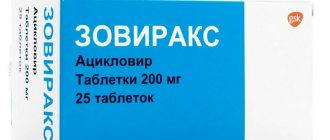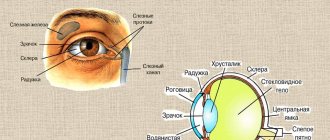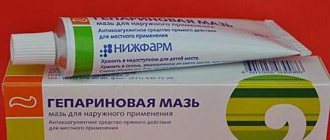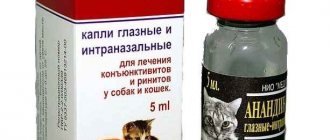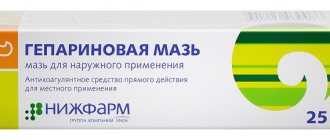The instructions for yellow mercury ointment indicate that its use is recommended for the treatment of eye and skin diseases. The external drug has a pronounced antiseptic effect and helps eliminate inflammation. Its use may cause side effects, so before using the ointment, consult a specialist.
Mercury yellow ointment - composition and release form
The active component is mercury oxide, which has a detrimental effect on pathogenic microorganisms that are the source of the inflammatory process. When applied to the skin, it has a drying effect.
The drug contains the following auxiliary components that have a softening and moisturizing effect, which helps reduce the risk of dry skin:
- lanolin;
- Vaseline oil.
Some manufacturers add a small amount of glycerin and purified water.
The product is a homogeneous, creamy mass. It can be light or bright yellow. It is packaged in aluminum tubes of different volumes, which are then placed in a cardboard box and the manufacturer’s data and expiration dates are indicated on it. You can buy yellow mercury ointment at a pharmacy without a prescription.
The product should be stored in a dark place, for a maximum of 5 years, if the seal of the tube is not broken. After the expiration date, it is strictly prohibited to use the drug for treatment.
How is it prescribed?
To purchase mercury yellow ointment at a pharmacy, you must provide a prescription signed by your doctor. This is a kind of confirmation that vision diseases can only be cured with such a drug. As for the dosage, it is prescribed only by the attending physician. Moreover, each disease requires a certain amount of medicine. There are no general recommendations for the use of this drug. Therefore, you cannot self-medicate. After all, mercury ointment can cause undesirable results.
Instructions for use of yellow mercury ointment
Depending on the type of disease, the following methods of using the drug are recommended:
- dermatological pathologies - a thin layer of the product is applied to the skin in the affected area 2 p. per day, without rubbing;
- eye diseases – 2 r. per day is placed under the lower eyelid.
The duration of the treatment course is determined individually by the attending physician (dermatologist or ophthalmologist) and can be 5-12 days. Using the ointment for longer than the permitted period will lead to side effects.
When applying the drug, it is necessary to avoid contact with the mucous membranes of the nose and mouth, as this will lead to the penetration of mercury into the digestive system and will cause serious poisoning and damage to the gastrointestinal tract.
Due to rapid absorption, the appearance of greasy marks on clothing fabrics is eliminated.
The product must be kept away from children and when using it, make sure that particles do not remain within the child’s reach (floor, clothing). The ointment is excreted within 24 hours in the urine, so the patient is not at risk of its accumulation in the tissues. The positive effect of the treatment is noticeable after the first application.
Yellow-mercury eye ointment: properties, eye treatment
March 10, 2018
Mercury ointment is a generalized name for a whole group of drugs that contain mercury compounds intended for the treatment of various diseases of the mucous membrane of the eyes or the skin around them.
The most popular among such products is yellow mercury eye ointment.
It should be noted that the high demand for this medication is associated not only with an affordable price for everyone, but also with many positive qualities.
Types of mercury ointments
There are several types of mercury external agents. They all have individual characteristics, so they are prescribed in specific cases:
- White ointment - used for pustular pathologies of the epidermis, furunculosis, exudative diathesis.
- Gray (sulfur-mercury) ointment - indicated for parasitic skin diseases.
- Yellow – effective for dermatological pathologies and inflammatory eye diseases.
Description and composition of yellow mercury ointment
Mercury yellow ointment is a homogeneous substance of creamy consistency, the color of which varies from light, almost white, to bright yellow. The preparation is based on sedimentary yellow mercury, petroleum jelly, lanolin, as well as a small amount of glycerin and purified water. The drug is marketed in aluminum tubes of various sizes.
Note! Despite the fact that the ointment is available without a prescription, it can only be used after consulting a doctor, since mercury, recognized as a toxic substance, can provoke the development of unpleasant complications.
Storage
The shelf life of yellow mercury ointment is five years, provided that it is stored in complete darkness and the tube is tightly screwed. The use of the drug after the end of the specified period is strictly prohibited.
Pharmacological effects
Yellow mercury-based ointment is a topical remedy.
It is perfectly absorbed into the skin or mucous membranes and effectively affects pathogenic organisms, disrupting their metabolism and further reproduction.
Thus, the affected area is disinfected, which promotes accelerated tissue restoration and rapid recovery. The therapeutic effect is observed after the first use.
It was noted that mercury ointment does not accumulate in tissues. It is excreted from the body by the kidneys (along with urine).
Important! Too long use, as well as accidental or intentional overdose, can still lead to the accumulation of the main active component in the blood with its subsequent distribution to vital organs, which is fraught with the development of various pathologies.
Indications and contraindications for use
Mercury ointment is used to treat inflammatory diseases on the skin around the eyes, as well as infectious processes on the mucous membrane of the organs of vision. The product is used:
- To eliminate minor damage to the skin (cuts, abrasions, wounds), as a result of which the affected skin appears inflamed.
- With keratitis - inflammation of the cornea of the eye.
- In complex therapy for blepharitis, conjunctivitis.
- Chalazion is a blockage of the sebaceous gland of the eyelid.
- For various pustular skin diseases and dermatitis.
Note! A positive result after using a mercury-based ointment is possible only if all the doctor’s recommendations are followed and the specifics of use specified in the instructions are taken into account.
Given the toxicity of mercury, it is not surprising that this drug has a number of contraindications. These include:
- increased sensitivity to mercury;
- individual intolerance to auxiliary components;
- age up to 12 years;
- pregnancy. The only exceptions are those cases when the potential benefit to the mother outweighs the possible risk to the child. Mercury medications pose a particular danger in the early stages of pregnancy, when all organs and systems are developing. As a result of intoxication, the baby may develop multiple congenital pathologies - from disorders of the kidneys and gastrointestinal tract to hysterical seizures and neurological disorders, even mental retardation;
- lactation period. The components of the ointment tend to penetrate into breast milk, causing nervous disorders and disruptions in the baby's digestive processes. If there is an urgent need for their use, then stop breastfeeding;
- tendency to allergic manifestations;
- tuberculosis;
- pathologies of the gastrointestinal tract, liver, kidneys, nervous disorders;
- eczema.
Mode of application
For dermatological diseases, squeeze out a small amount of ointment from the tube and apply it to the affected area (without rubbing into the skin) no more than twice a day. To treat eye pathologies, a thin strip of the product is placed under the lower eyelid twice a day. The course of treatment is determined individually and ranges from 5 to 12 (but no more!) days.
The use of yellow mercury ointment in childhood, as well as by pregnant and lactating women, is extremely undesirable. But, if such a need arises, then the drug can be applied very carefully and only under medical supervision.
Attention! The simultaneous use of mercury ointment and medications that contain iodine, bromine or dionine is strictly contraindicated! Therefore, it is important to inform your doctor about the medications that the patient is taking.
When applying the product, do not allow it to come into contact with the mucous membranes of the mouth or nasal cavity - this is equivalent to swallowing a medication and is considered very dangerous. In addition, do not apply the ointment to damaged skin.
After applying the product, wash your hands thoroughly. If there are small children in the house, then you should make sure that the ointment does not get on the floor or other surfaces, as well as clothes, and is completely out of reach of the baby.
Side effects
Yellow mercury ointment can cause the patient to develop the following undesirable effects:
- From the digestive system - bloating, nausea, flatulence.
- From the urinary system - kidney damage, frequent urge to urinate.
- From the side of the central nervous system - drowsiness, irritability, trembling of the limbs, apathy.
- Other manifestations are menstrual irregularities, skin reactions, increased sensitivity to odors.
When used correctly, such conditions occur extremely rarely. If any atypical manifestations were noted during the use of the drug, then its use must be stopped immediately.
Overdose
Intentionally or accidentally exceeding the recommended dose may result in mercury poisoning (mercurialism). The following symptoms may indicate its development:
- increased fatigue and unexplained weakness;
- nervousness, irritability, aggressiveness;
- insomnia, nightmares, feelings of fear or panic;
- impaired attention or problems remembering information;
- urinating too frequently;
- trembling of the eyelids or limbs;
- hair loss, deterioration of nails;
- hallucinations or signs of kidney and liver damage (indicate a high degree of poisoning).
Need to know! Mercury poisoning occurs gradually. Experts identify three main stages of its progression.
Initially, the patient may feel some weakness along with increased anxiety, and also notice trembling of the fingers. If such a condition manifests itself against the background or after using mercury ointment, then you need to contact a specialist as soon as possible - it is in the early stages that mercury intoxication can be completely cured.
As mercurialism progresses, the patient experiences an increase in tremor, anxiety, and irritability. A person has problems sleeping.
Such symptoms, left unattended, in a short time flow into the final, most difficult stage, often ending in death due to disturbances in the functioning of the liver, kidneys or thyroid gland.
In this case, even the surviving patient will constantly suffer from certain systemic pathologies.
Patient reviews
The opinion of people who have previously used mercury ointment is quite ambiguous:
- I suffered from chalazion, and my friends recommended yellow mercury ointment. With great difficulty I got hold of this miracle remedy and started using it as written in the instructions. As a result, she received a burn to her eyelid. I am disappointed. Veronica, 42 years old;
- I have a predisposition to conjunctivitis. I always save myself only with mercury yellow ointment, it has never let me down. Nadezhda Nikolaevna, 58 years old;
- I ordered an ointment online to treat stye. The result is amazing! Svetlana, 35 years old;
- The use of this product ended with a severe allergic reaction for me already on the second day of application. My eyes itched and burned unbearably! Anatoly, 32 years old.
Analogs
Unfortunately, yellow-mercury eye ointment is not currently sold by domestic pharmacy chains. Due to the high toxicity of mercury, pharmacies do not produce this product to order. There are no analogues of mercury ointment. But, despite the fact that drugs with similar composition cannot be found, an experienced doctor will be able to select another medicine that is similar in effect.
If you are lucky enough to get the desired remedy, then before using it you must undergo a medical examination and consult with a dermatologist or ophthalmologist. Despite the pronounced therapeutic effect, unauthorized use of this drug may not have the best effect on the well-being and health of the patient.
Source: //recepty-prirody.ru/zdorove/mazi/zheltaya-rtutnaya-maz.html
Indications and contraindications
Treatment with yellow mercury ointment is prescribed when the following pathologies are detected:
- furunculosis;
- streptococcal impetigo;
- demodicosis;
- frequent occurrence of acne on the skin;
- dermatitis;
- skin diseases accompanied by the appearance of ulcers;
- chalazion;
- blepharitis;
- keratitis;
- conjunctivitis;
- inflammation of the mucous membrane of the eye.
There is also a list of contraindications:
- individual intolerance or hypersensitivity to the components of the drug;
- predisposition to allergies;
- eczema;
- tuberculosis;
- neuropsychiatric disorders;
- diseases of the kidneys, liver and gastrointestinal tract;
- age up to 12 years;
- breast-feeding. The substances that make up the ointment penetrate into the milk and cause nervous system disorders in the baby;
- pregnancy.
You should not make a choice in favor of this drug on your own, as it has a number of side effects.
Dosages and instructions for use
The standard course of treatment lasts from 6 to 12 days. It is prohibited to use liniment without interruption for longer, as it can cause intoxication of the body. The optimal number of sessions is 2 times a day. Yellow ointment is applied in a thin layer to the eyelid. You can't rub it in. An alternative option is to place liniment under the lower eyelid. Distribute the medication evenly using pre-disinfected fingers or cotton pads.
After the treatment session, you should wash your hands thoroughly. Do not allow liniment to get into your mouth or nostrils. In this case, you must immediately wash your face with running water and induce a gag reflex by pressing two fingers on the root of your tongue. If the concentration of the substance is high, you should go to the hospital. More detailed instructions for use indicating the frequency of application are issued by an ophthalmologist. The ointment must be stored tightly closed in complete darkness. The product is dangerous for children and should therefore be kept out of their reach.
Can it be used by children and pregnant women?
The use of yellow mercury ointment in the treatment of pregnant women and children under 12 years of age is highly undesirable. Children's skin is still very delicate and highly sensitive, which can lead to allergic reactions.
The use of drugs containing mercury during pregnancy is prohibited due to its toxic effects on the body. This will negatively affect the condition of the fetus, causing the development of congenital diseases.
Especially the ointment should not be used in the first trimester, when the formation of the child’s organs and systems occurs.
The drug is allowed to be prescribed only in cases of urgent need, when the positive effect of its use exceeds the strength of the negative impact on the body of the mother and fetus. In this case, the ointment can be applied in a small amount, only 1 r. per day, constantly monitoring the patient's condition. If it worsens and adverse reactions occur, then it is necessary to suspend such treatment.
What can be replaced?
There are no similar mercury-based drugs used to treat ophthalmic diseases. Before going to bed, the application of Cyclomed or Hydrocortisone may be prescribed, but they cannot be used more than once a day. The ophthalmologist also often prescribes Okomistin, Visin, Furacilin or Normax drops for mild forms of the inflammatory process. You can instill the product 5-6 times a day. White mercury ointment is effective in the treatment of purulent formations. Before use, you need to study contraindications.
Treatment with yellow mercury ointment for chalazion
If a patient is diagnosed with chronic proliferative inflammation of the eyelid margin around his cartilage and meibomian gland, the product is applied to nodules that have not yet reached a size exceeding 0.5 mm and become denser as follows:
- adults - 2 rubles. per day, the ointment should be placed behind the lower eyelid;
- for children - for several hours 1 rub. a day, place a piece of gauze with a small amount of ointment on the eyelid and secure it with a bandage
It is recommended to carry out manipulation during daytime sleep. At the end of the treatment procedure, the patch is moistened with water so that the skin is not damaged during its removal.
The product helps soften the capsule and release pus, while simultaneously providing an antiseptic effect.
If after 12 days there is no improvement, then another drug is selected.
Indications for use
In ophthalmology, mercury yellow ointment is prescribed for such pathological processes as:
- keratitis (inflammation of the cornea);
- blepharitis (inflammation of the edges of the eyelids);
- conjunctivitis of various origins (inflammatory processes of the outer membrane of the eyes);
- barley (acute inflammation of the hair follicle of the eyelash) at the stage of discharge of purulent masses;
- chalazion (chronic inflammation of the eyelid margin, which develops around the eyelid cartilage and meibomian gland. It is a benign tumor-type seal).
Dermatitis on the eyelids is also an indication for the use of this drug. The group of indications also includes ulcers, cuts and scratches on the skin of the eyelids and the cornea of the organs of vision.
If the pathological process of the organs of vision spreads to the skin around them, then it can also be lubricated with a preparation containing mercury.
Possible side effects
The following adverse reactions were recorded during use:
- flatulence
- nausea;
- bloating;
- increased urination;
- disruptions in kidney function;
- trembling in the limbs;
- drowsiness;
- irritability;
- apathy;
- redness of the skin;
- menstrual irregularities;
- increased sensitivity to odors.
If a person does not deviate from the rules of the instructions for using the drug, then such reactions of the body occur mainly separately and in isolated cases. If other unpleasant symptoms occur, treatment with ointment should be abandoned.
In case of overdose, mercury oxide poisoning occurs, as indicated by the following symptoms:
- constant weakness;
- severe fatigue;
- sleep disturbance (insomnia);
- aggressiveness;
- irritability;
- the appearance of nightmares;
- hair loss and brittle nails;
- frequent urination;
- hallucinations;
- trembling of fingers and eyelids;
- tremor.
If the patient does not notice the first signs of poisoning in time and does not seek medical help, liver and kidney dysfunction will gradually develop, which will lead to death. If a person can be saved, then for the rest of his life he will need to treat the pathologies of these organs.
Side effects
Side effects develop with prolonged use of mercury ointment. These include:
- tremor of the upper extremities;
- menstrual irregularities in women;
- bloating;
- flatulence;
- local symptoms of irritation (itching, severe burning);
- redness of the skin around the treated area in case of hypersensitivity;
- drowsiness;
- increased irritability, mood swings;
- impaired perception of smells;
- frequent urge to urinate due to impaired renal function;
- severe bleeding gums.
If severe side effects occur, you should stop using the ointment to avoid mercury poisoning. In this case, you should consult a doctor to correct the therapeutic course.
Improper use of this eye ointment can cause mercury poisoning. Symptoms of poisoning:
- general exhaustion;
- memory impairment;
- panic attacks;
- trembling of the eyelids and eyes;
- severe hair loss;
- delamination of the nail plates.
Intoxication develops gradually and occurs in 3 stages. Initially, the patient experiences weakness and feels trembling of the fingers; at the next stage of poisoning, he suffers from nervous system disorders: insomnia, increased anxiety, depression.
At the last stage of mercury intoxication, internal organs are damaged: kidneys, liver, thyroid gland. Changes occur that can cause the development of chronic diseases of the heart muscle, nervous system, or cause death.
How it interacts with other means
The drug should not be used together with medications containing the following substances:
- bromine;
- iodine;
- dionin.
If you have been prescribed one of these medications, you should inform your treating ophthalmologist or dermatologist.
Methods of application
The ointment is applied only topically, to the skin of the eyelids or under the eyelid to the mucous membrane in a thin layer. The dosage and frequency of use per day are prescribed only by a doctor based on the symptoms and severity of the disease. Since this substance is toxic in large quantities, violating the dosage and using the product in large quantities is not recommended.
Yellow mercury ointment is used strictly externally in the dosage specified by the doctor.
Gently squeeze the product out of the tube onto the affected area and spread it with a cotton swab or fingertip. Hands should be washed thoroughly with soap after the procedure.
